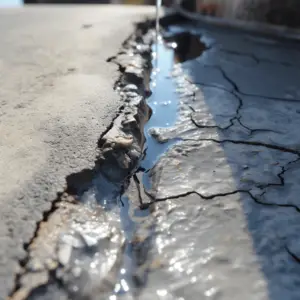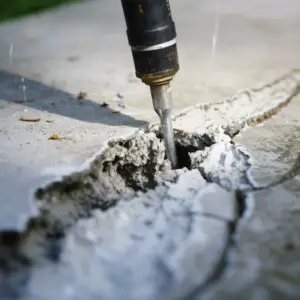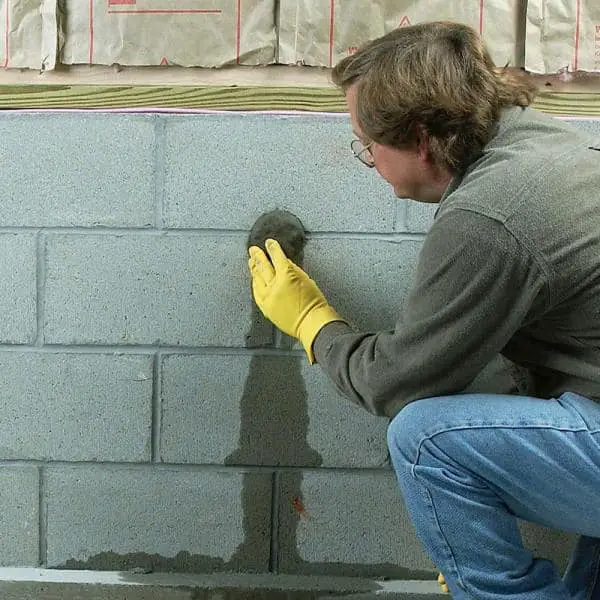Epoxy and Hydraulic Cement are two of the most popular materials used to repair cracks in concrete. Both can be used to repair cracks in everything from driveways and patios to sidewalks and foundation slabs. Epoxy and Hydraulic Cement both have similar goals, but they go about achieving those goals in different ways.
In order to understand which of these repair materials is right for your project, it is important to know what they are and how they work.
Table of Contents
Epoxy vs Hydraulic Cement: Overview

What is Epoxy?
Epoxy is a thermosetting polymer, which means that when it is cured it will retain its shape regardless of how much heat you apply. It is also known as a resin and can be used to coat surfaces. It is often used in paints, adhesives, and coatings.
The way Epoxy works is by having two parts, which are the resin and the hardener. They need to be mixed together in order for the epoxy to cure correctly. The time it takes for them to cure depends on their chemical composition and the temperature of your environment.
What is Hydraulic Cement?
Hydraulic cement is also known as hydraulic lime, and it was used by the ancient Romans and Greeks for construction purposes. It was created by mixing lime with volcanic ash, but now it is made from limestone mixed with clay or gypsum.
Hydraulic cement works by expanding once water is added to it. This makes it an ideal material for filling cracks in concrete because it will expand into the crack instead of just sitting there as mortar would do.
Both epoxy and hydraulic cement are used in the same type of applications, specifically patching or sealing leaks and cracks in concrete. Both products are available in a wide variety of colors and are long-lasting; however, there are some key differences between them to be aware of.
What are the Differences Between Epoxy vs Hydraulic Cement?
Composition:
The composition of epoxy is fairly simple: two parts resin to one part hardener. The resin and hardener are combined in a mixing cup, then stirred together before being applied with a trowel. The resulting compound forms a hard, plastic-like material that adheres tightly to concrete.
Hydraulic cement is essentially powdered limestone mixed with water until it reaches a putty-like consistency. Once applied and set, hydraulic cement forms an extremely dense barrier that’s almost impossible to penetrate!
Adhesion:
Epoxy adheres well to most surfaces, including concrete, aluminum, and wood. Epoxy will not adhere well to greasy or oily surfaces, so any surface that has been contaminated with petroleum products must be cleaned thoroughly before applying the epoxy.
Hydraulic cement is used to hold bricks and rocks in place for building or repair projects, and it adheres well to such surfaces. It can also be used to fill cracks or gaps in existing structures.
Application:
Epoxy can be applied with a brush or a sprayer, making application easy. It can also be used for many applications, including bonding wood to concrete and sealing pipes.
Hydraulic cement must be mixed before use and usually needs to be troweled on the surface of the repair area using a putty knife or trowel. This makes it more difficult to apply than epoxy because it requires special tools and skills from the user.
Epoxy can be used in wet as well as dry conditions. It will harden relatively fast and can be repositioned during application if you need it to be moved. Hydraulic cement can only be used in dry conditions and should not be applied underwater.
Dry Time:
Epoxy has a very fast dry time, allowing users to get back to work quickly after applying it to their projects. It can also be used underwater because of its quick curing time!
Hydraulic cement takes longer to dry than epoxy because of its thick consistency and high viscosity (think molasses).
Which is stronger: Epoxy or Hydraulic Cement?
Mixing epoxy with hardener creates a strong and durable material, but it won’t necessarily be stronger than hydraulic cement. As you mix water into it, the particles of cement separate and reform around aggregates like sand or stone, creating a rock-solid material that is extremely resistant to cracking.
The strength of your repair will depend on the amount of aggregate in your mix as well as how thoroughly you’ve mixed it. Be sure to follow the manufacturer’s instructions carefully when mixing your hydraulic cement. Also, remember that concrete needs time to cure before it reaches its full strength potential.
Epoxy vs Hydraulic Cement: Which One Should You Use?

When you’re dealing with something as serious as a crack in a foundation or basement wall, it’s best to act fast. Foundation cracks are one of the most common issues homeowners encounter, but they are one of the biggest threats to your home’s stability and value.
Cracks can be caused by everything from flooding to tree root growth, but the result is always the same: you need to find a solution that will keep your home safe while also keeping costs low.
If you’re looking to fix a cracked wall, you’re wondering which one of these products you should use. The short answer is, it depends on the damage. Epoxy and hydraulic cement are made for different kinds of damage, and both have their place when it comes to masonry repair.
When to Use Hydraulic Cement?
Hydraulic cement is suitable for smaller cracks because it expands as it cures and seals out water. These types of cracks are usually caused by shifts in temperature or soil movement, but they don’t usually cause structural damage to the building.
Where can You use an Epoxy?
The great thing about epoxies is that they stick to nearly any surface. They are great for creating a bond between wood, metal, stone, concrete, and more! However, if you have an oily surface, you may need to use a different type of adhesive to get these surfaces to adhere together properly.
Depending on the type of epoxy you choose for your project, some may not be waterproof at all, while others will hold up well underwater or even in freezing temperatures without cracking or breaking apart over time like other adhesives might do when exposed to extreme weather conditions such as these.


